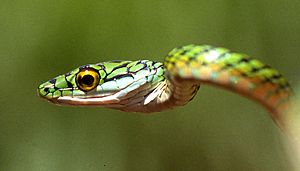Parrot snake facts for kids
Quick facts for kids Parrot snake |
|
|---|---|
 |
|
| Conservation status | |
| Scientific classification | |
| Genus: |
Leptophis
|
| Species: |
ahaetulla
|
| Synonyms | |
|
|
The Leptophis ahaetulla, also known as the lora or parrot snake, is a type of medium-sized, thin snake. It belongs to the Colubridae family, which includes many common snakes. This snake is found only in Central America and the northern parts of South America.
Contents
Where Does the Parrot Snake Live?
The parrot snake lives in many countries across Central and South America. It is found in:
- Central America: Belize, Costa Rica, El Salvador, Guatemala, Honduras, southern Mexico, Nicaragua, Panama.
- South America: Argentina, Bolivia, Brazil, Colombia, Ecuador, French Guiana, Paraguay, Peru, Trinidad and Tobago, Uruguay, Venezuela.
What Does the Parrot Snake Look Like?
Adult parrot snakes can grow to be quite long, up to about 172 centimeters (about 5.6 feet) in total length. Their tail alone can be around 59 centimeters (about 1.9 feet) long.
The parrot snake is usually bright green, golden, or bronze on its back. The edges of its scales might be black or dark brown. It also has a black stripe on each side of its head that goes through its eye. The snake's upper lip and belly are typically white or yellow.
Is the Parrot Snake Venomous?
For a long time, people thought the parrot snake was not venomous. However, it is now known to be mildly venomous. If it bites, you might feel some local pain, swelling, and a tingling sensation, like "pins and needles." These feelings usually go away after a few hours.
Body Features
The parrot snake has a long head that stands out from its neck. It has large eyes with round pupils. Its body is slender, and its tail is very long.
The scales on its back are arranged in rows and are mostly ridged, except for the row closest to its belly, which are smooth. The scales on its neck and tail are also smooth.
What Does the Parrot Snake Eat?
The parrot snake is a carnivore, meaning it eats other animals. Its diet includes:
Interestingly, parrot snakes are also known to eat other snakes, which is a rare behavior for many snake species.
See also
 In Spanish: Leptophis ahaetulla para niños
In Spanish: Leptophis ahaetulla para niños



